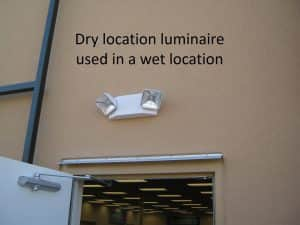Passing Your Emergency Lighting Inspection
Published on October 21, 2014 by JADE Learning
Having worked as an Electrical Inspector for many years, I can honestly say that emergency lighting issues create some of the biggest problems during the final inspection. Here are the top 5 most common problems that arise and how they relate to the NEC:
1. Exit signs/Emergency lights (Unit Equipment) not fed from the same circuit as the normal area lighting.
Section 700.12(F)(2) requires the exit sign/emergency lights to be fed from the same circuit that provides the normal area lighting (check the exception). The idea is to ensure that if power fails to a certain area of the building, or to the entire building during an emergency, the emergency lights will illuminate for at least 90 minutes (Building Code requirement) so that occupants can safely exit the building. If a normal area lighting circuit fails, and the emergency lights are not supplied from that same circuit, then the area will be in darkness even if that area is equipped with emergency lights. This is because most emergency lights only illuminate when their normal power source fails.
2. Exit signs/Emergency lights not functioning on battery power when circuit breaker is turned off.
Simple enough. If there is an exit sign or emergency light installed, then it should function on battery power when the circuit breaker supplying it is turned off. Many times, these luminaires are shipped with the backup battery unplugged and the installer simply forgets to plug-in the battery leads. If the light is not equipped with a backup battery but is fed from an emergency panel supplied by an emergency source, then the exit sign/emergency light should illuminate within 10 seconds of a simulated power failure per 700.12.
3. Exit signs/Emergency lights missing or wrong type.

Another easy fix. If the plans show ten emergency lights and two exit signs on the lighting page, then install ten emergency lights and two exit signs. Illumination levels (foot-candles) are considered when emergency lighting plans are drawn. Acting on a last minute change order and swapping one type of emergency light for another might create a lower level of illumination for the area served.
4. Exit signs/Emergency lights only operating on one lamp when circuit is turned off.
700.16 requires the emergency lights to be arranged so that the failure of one lamp does not leave the area requiring emergency lights in total darkness. Quite often, the plans will show a two lamp fixture that functions as the normal area lighting source when power is on, and doubles as an emergency light during a power failure. A problem occurs when the emergency ballast is designed to illuminate only one of the two lamps during a power failure. In this case, two luminaires would be required to serve the area in order to comply with 700.16.
5. Exterior emergency lights without a time delay feature serving an area where the normal area lighting is high-intensity discharge (HID).

700.16 specifies that if HID lighting such as high and low-pressure sodium, mercury vapor, and metal halide is used for normal illumination, the emergency lighting system is required to operate until normal illumination is restored. Simply put, if HID luminaires provide normal area illumination and are not equipped with an instant restrike feature, then the emergency light should remain on after power is restored and until the HID luminaire warms up.
